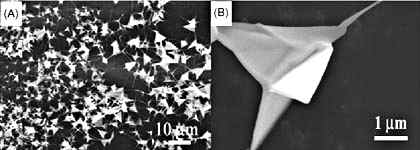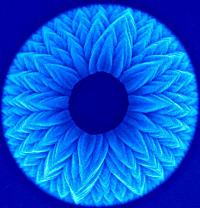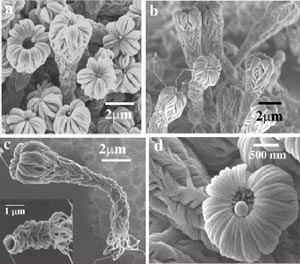 |
 |
Great Debates |
 |
 |
Main Menu |
 |
 |
Ephemerids |
 |
 |
On this day
in...
1836
HMS Beagle anchors at
Angra Azores
1839
Details of Louis Daguerre's 1st
practical photographic process are released in
Paris
1891
William Huggins describes astronomical
application of spectrum
1897
1st electric taxi's
drive in London
1913
Frenchman P‚goud makes 1st
parachute jump in Europe | |
 |
|
 |
 Summary: For both
scientists and artists in the field of nanotechnology, making
tiny airplanes and flower-like designs on scales smaller than
the width of a human hair showcases the large promise of
thinking small. Summary: For both
scientists and artists in the field of nanotechnology, making
tiny airplanes and flower-like designs on scales smaller than
the width of a human hair showcases the large promise of
thinking small.
Display Options:

















Fantastic Voyage
Science and Art in Nanoworldbased on Institute of Physics
reports
 |
| Nanoflowers of silicon
carbide, synthesized with widths less than a human hair.
Banner image of nano-airplanes as novel self-assembled
nanostructures (nanoairplanes, nanocombs, and
tetrapod-like networks of zinc oxide) by a simple
thermal evaporation technique in a single-stage furnace.
Image Credit: IOP/Wei Ho (Flowers) and Airplanes
(Liu) |
Some of the most
beautiful science images of the year so far are found in a
collection of photomicrographs of tiny "flowers" and "trees"
less than one thousandth the width of a human hair. The images
are published in the Institute of Physics journal,
Nanotechnology.
"Nano-" is Greek for dwarf. A
nanometer is one billionth of a meter --approximately ten
times the diameter of the hydrogen atom--and nanotechnology is
the design and manufacture of artifacts in the range of 100
nanometers to 0.1 nanometers. In his visionary lecture
delivered at Caltech in 1959, Nobel Laureate Richard Feynmann
gave the idea of nanotechnology a quantitative look in his talk
entitled: "There is Plenty of Room at the Bottom". From the
outset Feymann asked: "Why can't we write the entire 24
volumes of the Encyclopedia Britannica on the head of a pin?"
After four decades, his predictions have proven quite
descriptive.
To showcase imaginative examples, new
images were taken by Ghim Wei Ho, a PhD student studying nanotechnology
at Cambridge University. She has named some of her best
photographs nanobouquet, nanotrees, and nanoflower because of
their curious similarity to familiar organic structures such
as flower-heads and tiny growing trees.
Ghim Wei's
work involves making new types of materials based on
nanotechnology and these flowers are an example of such a new
material. Here, nanometer scale wires (about one thousandth
the diameter of a human hair) of a silicon-carbon material
(silicon carbide) are grown from tiny droplets of a liquid
metal (Gallium) on a silicon surface, like the chips inside
home computers.
The wires grow as a gas containing
methane flows over the surface. The gas reacts at the surface
of the droplets and condenses to form the wires. By changing
the temperature and pressure of the growth process the wires
can be controllably fused together in a natural process to
form a range of new structures including these flower-like
materials.
 |
Silicon carbide nanoflowers and
nanotrees.
Credit:IOP/Wei Ho
|
Professor Mark Welland, head of
Cambridge's Nanoscale Science Laboratory and Ghim Wei's
supervisor, said: "The unique structures shown in these images
will have a range of exciting applications. Two that are
currently being explored are their use as water repellant
coatings and as a base for a new type of solar cell. We have
already shown that as a coating water droplets roll off these
surfaces when they are tilted at angles as small as 5 degrees.
This behavior is a direct consequence of the ability of such
nanostructured surfaces to strongly repel water".
Dr
Paul Danielsen, director of communications at the Institute of
Physics, said: "Science can be beautiful. These images show
cutting edge nanotechnology research but are strikingly images
in their own right. Maybe science and art aren't so different
after all."
Several techniques have already been
developed for synthesizing silicon carbide (SiC) material in
the form of nanospheres and nanowires/rods. The new report
describes the synthesis of a distinctly different kind of SiC
nanostructure in the form of three-dimensional crystalline
nanowire-based flower-like structures. Interest in such
structures centers around the combination of a simple growth
process based on SiC nanowire formation, with a resultant
structure having potentially complex mechanical and optical
properties.
A second paper in the same issue of
Nanotechnology describes a process of making networks of zinc
oxide into shapes resembling airplanes and combs (see banner
image). The typical scale of these tiny machine replicas is
about one micron.
 |
Classic 1966 film,
Fantastic Voyage, based on book by science fiction
writer Isaac Asimov.
Credit: IMdb
|
As highlighted in the (1966)
film and book, Fantastic
Voyage (by Isaac Asimov), the idea of nanomachines
interacting with biological cells has captured the imagination
of both researchers and speculative fiction writers. The
Asimov classic details how a miniaturized surgical team gets
inserted into a dying man and eventually explores the
patient's brain and circulatory systems.
To compare
these recent images to the expectations of a typical
biological cell's size, 200 nanometers is probably the
limit for any cell to contain the machinery of life like
replicating DNA. "Generally," said medical microbiologist Neva
Ciftcioglu, at NASA's Johnson Space Center in Houston, "we
say that a microorganism should not be any smaller than 200
nanometers. So nanobacteria is within this range, however,
there are some forms we detected that they are even 80 or 50
nanometers." These smaller forms, she says however, may not be
complete cells.
So on a relative scale, the
smallest biological cell would tower over these nanoflowers
and nanoairplanes-- much like a 80-story skyscraper towers
over a person looking up from ground level to the top floor.
Or as Richard Feynmann titled his imaginative survey, "There
is plenty of room at the bottom."
Related Web PagesNanobes:
A New Form of Life?
Expanding
the Genetic Code
Extraterrestrial
Capture
Interplanetary
Internet
Life's
Recipe Card
Chomping
on Nano-Nuggets
Small
World
Nanobac Oy
NanobacLabs.
Note:
Missions
Display Options:
















Friday, June 25, 2004
|
|
| Fantastic
Voyage | Login/Create an
account | 0 Comments |
|
|
| Comments are
owned by the poster. We aren't responsible for their
content. |
|
 |